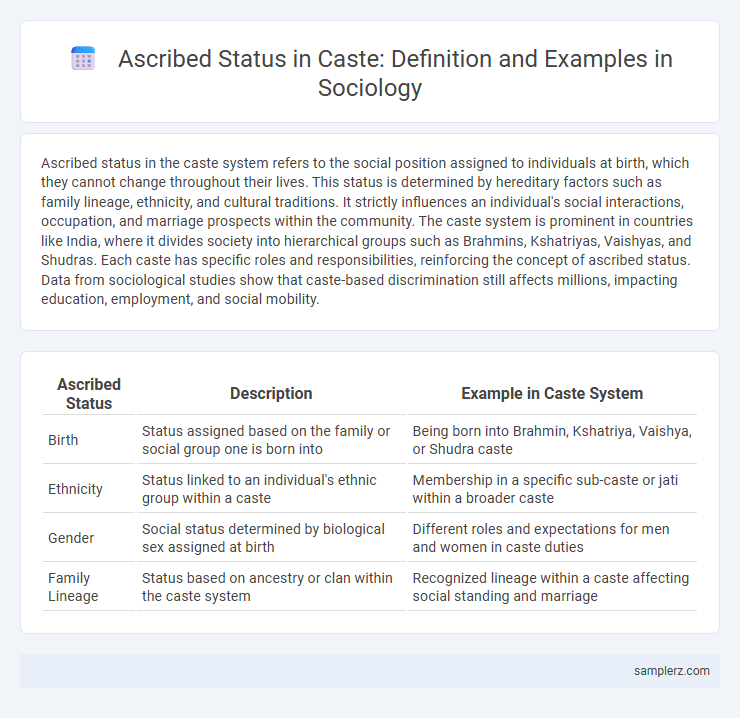Ascribed status in the caste system refers to the social position assigned to individuals at birth, which they cannot change throughout their lives. This status is determined by hereditary factors such as family lineage, ethnicity, and cultural traditions. It strictly influences an individual's social interactions, occupation, and marriage prospects within the community. The caste system is prominent in countries like India, where it divides society into hierarchical groups such as Brahmins, Kshatriyas, Vaishyas, and Shudras. Each caste has specific roles and responsibilities, reinforcing the concept of ascribed status. Data from sociological studies show that caste-based discrimination still affects millions, impacting education, employment, and social mobility.
Table of Comparison
| Ascribed Status | Description | Example in Caste System |
|---|---|---|
| Birth | Status assigned based on the family or social group one is born into | Being born into Brahmin, Kshatriya, Vaishya, or Shudra caste |
| Ethnicity | Status linked to an individual's ethnic group within a caste | Membership in a specific sub-caste or jati within a broader caste |
| Gender | Social status determined by biological sex assigned at birth | Different roles and expectations for men and women in caste duties |
| Family Lineage | Status based on ancestry or clan within the caste system | Recognized lineage within a caste affecting social standing and marriage |
Understanding Ascribed Status in Caste Systems
Ascribed status in caste systems is determined by birth and remains fixed throughout an individual's life, reflecting deeply entrenched social hierarchies. Individuals inherit their caste, which dictates their social roles, occupational opportunities, and community interactions, limiting social mobility. This rigid classification reinforces inequalities and shapes identity within societies that uphold caste-based structures.
Birth and Family Lineage as Ascribed Statuses
Ascribed status in caste systems is primarily determined by birth, where an individual's social position is inherited from their family lineage without regard to personal achievements. This hereditary status dictates access to privileges, occupations, and social interactions, reinforcing the rigid social hierarchy. Family lineage ensures that caste identity and associated roles are maintained across generations, shaping an individual's societal opportunities from birth.
Gender Roles within Caste Hierarchies
Gender roles within caste hierarchies are rigidly defined, with women often assigned duties related to household management, child-rearing, and maintaining family honor. These roles reinforce ascribed status by limiting social mobility and perpetuating traditional expectations tied to birth and caste identity. In many caste systems, women's behavior and opportunities are strictly controlled to uphold the hierarchical structure and social order.
Religious Identity and Caste Assignments
Religious identity plays a significant role in ascribed status within caste systems, where individuals are assigned social positions based on birth rather than personal achievement. Hindu caste assignments often link specific religious practices and rituals to particular groups, reinforcing hereditary social hierarchy. This interconnection between religion and caste perpetuates social stratification, influencing access to resources and social privileges.
Hereditary Occupations as Caste Markers
Hereditary occupations serve as key caste markers, where individuals inherit specific jobs such as weaving, pottery, or priesthood based on their caste lineage. These occupational roles are rigidly maintained across generations, reinforcing social hierarchy and limiting upward mobility. The caste system thus institutionalizes ascribed status through the transmission of hereditary professions tied to social identity.
Regional Identity and Caste Membership
Ascribed status in caste is prominently observed through regional identity, where individuals inherit social positions based on birth within specific geographic locations associated with particular castes. This status dictates social roles, occupations, and community interactions, reinforcing caste membership without personal choice. Regional identity intertwines with caste membership to maintain traditional social hierarchy and cultural practices across generations.
Endogamy and Social Stratification
Ascribed status in caste systems is exemplified by endogamy, where individuals marry within their own social group, maintaining strict social boundaries and reinforcing hierarchical divisions. This practice perpetuates social stratification by limiting mobility and preserving inherited social roles and privileges. Such rigid endogamous customs sustain the caste structure and institutionalize inequality across generations.
Cultural Practices Shaped by Ascribed Status
Ascribed status in caste systems profoundly influences cultural practices such as religious rituals, marriage customs, and dietary restrictions, which are inherited rather than chosen. These cultural norms reinforce social hierarchy and communal identity, ensuring the continuity of caste distinctions across generations. For example, strict endogamy within caste groups preserves social boundaries and perpetuates ascribed status through lineage.
Intergenerational Transmission of Caste Status
Ascribed status in caste is exemplified by the intergenerational transmission of caste identity, where individuals inherit social positions based on their family lineage rather than personal achievements. This transmission perpetuates social stratification, limiting social mobility and reinforcing caste-based roles and privileges within society. Historical practices, such as endogamy and occupation-specific inheritance, further entrench caste status across generations.
Limitations and Social Mobility in Caste Systems
Ascribed status in caste systems often imposes significant limitations on individuals by assigning social positions at birth, restricting access to education, employment, and social networks. These rigid hierarchies severely hinder social mobility, confining individuals to the roles and occupations designated by their caste without opportunities for upward movement. The persistence of caste-based discrimination perpetuates inequality and reduces societal cohesion by reinforcing economic and social disparities across generations.

example of ascribed status in caste Infographic
 samplerz.com
samplerz.com